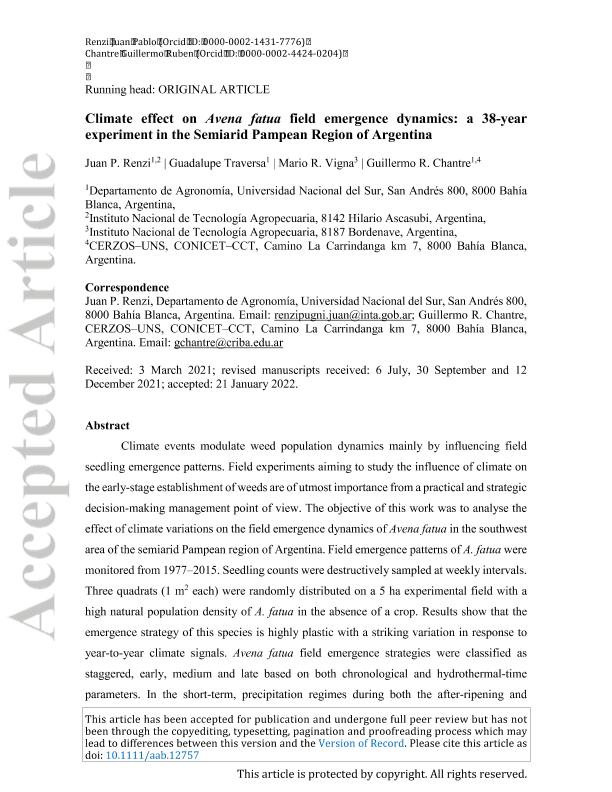Artículo
Climate effect on Avena fatua field emergence dynamics: A 38-year experiment in the semiarid Pampean region of Argentina
Fecha de publicación:
13/02/2022
Editorial:
Wiley Blackwell Publishing, Inc
Revista:
Annals of Applied Biology
ISSN:
0003-4746
Idioma:
Inglés
Tipo de recurso:
Artículo publicado
Clasificación temática:
Resumen
Climate events modulate weed population dynamics mainly by influencing field seedling emergence patterns. Field experiments aiming to study the influence of climate on the early-stage establishment of weeds are of utmost importance from a practical and strategic decision-making management point of view. The objective of this study was to analyse the effect of climate variations on the field emergence dynamics of Avena fatua in the southwest area of the semiarid Pampean region of Argentina. Field emergence patterns of A. fatua were monitored from 1977 to 2015. Seedling counts were destructively sampled at weekly intervals. Three quadrats (1 m2 each) were randomly distributed on a 5 ha experimental field with a high natural population density of A. fatua in the absence of a crop. Results show that the emergence strategy of this species is highly plastic with a striking variation in response to year-to-year climate signals. Avena fatua field emergence strategies were classified as staggered, early, medium and late based on both chronological and hydrothermal-time parameters. In the short-term, precipitation regimes during both the after-ripening and emergence phases largely explained the resulting emergence strategy. In the long-term, the combined effect of a reduction in both the precipitation frequency and the mean minimum temperature correlated with an increase in the staggered emergence pattern. Results also point out the adaptability of A. fatua in the area under study, further suggesting a bet-hedging fitness strategy that could diminish the risk of population decline under changing climate scenarios. From an agronomic perspective, the occurrence of staggered emergence patterns with an extended emergence window would complicate the definition of the optimal time for weed control. Thus, tailoring decisions based on the Southern Oscillation Index (SOI) episodes (neutral, negative or positive) forecast plus the implementation of weed emergence models could lead to more accurate and sustainable weed management decisions.
Archivos asociados
Licencia
Identificadores
Colecciones
Articulos(CERZOS)
Articulos de CENTRO REC.NAT.RENOVABLES DE ZONA SEMIARIDA(I)
Articulos de CENTRO REC.NAT.RENOVABLES DE ZONA SEMIARIDA(I)
Citación
Renzi, Juan Pablo; Traversa, Guadalupe; Vigna, Mario Raul; Chantre Balacca, Guillermo Ruben; Climate effect on Avena fatua field emergence dynamics: A 38-year experiment in the semiarid Pampean region of Argentina; Wiley Blackwell Publishing, Inc; Annals of Applied Biology; 181; 2; 13-2-2022; 182-191
Compartir
Altmétricas




